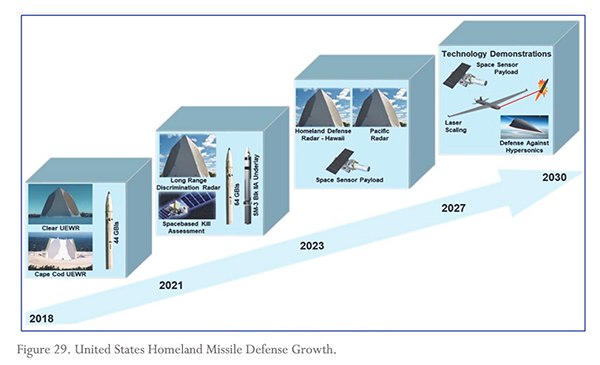
President Donald Trump unveils the Missile Defense Review in the Pentagon auditorium ?on Jan. 17. DOD photo by Army Sgt. Amber Smith.
The US military must invest in new technology quickly, and will not be limited in any way in how it defends against missile threats from both near-peer adversaries and rogue states, the Pentagon said in a long-awaited review of its missile defense.
The Missile Defense Review, Congressionally mandated and originally announced in May 2017, will officially be released on Thursday and lays the groundwork for how the US plans to defend itself from a “markedly more dangerous” world, which “demands a concerted US effort to improve existing capabilities.”
“Today we reaffirm that a strong America remains the best way to prevent conflict, promote peace, preserve freedom, and protect our great people,” President Donald Trump said during a speech at the Pentagon auditorium announcing the review. “Together, we unite behind a noble mission to shield our country with the greatest missile defense systems anywhere on the face of the Earth.”
?The review, which originally was called the Ballistic Missile Defense Review before being updated to reflect additional threats such as hypersonic weapons and advanced cruise missiles, will set guidelines for how the Pentagon will strengthen its defensive and offensive posture, Acting Defense Secretary Patrick Shanahan wrote in the report’s preface.
“Our missile defense systems constitute a cornerstone of our efforts to deter a missile attack by a rogue state and make a clear contribution to our alliances,” Shanahan wrote “They must be robust, ready, and fit for our times.”
Trump, during his speech, said the review has six main priorities that will guide the Pentagon in future budgets and decision making:
- Prioritize the defense of the US above all else.
- Focus on developing new technologies instead of simply money on existing systems.
- Protection from all types of missile attacks, not just ballistic missiles.
- Further the advancement of space as a warfighting domain.
- Remove bureaucratic obstacles to acquisition of missile defense systems.
- Push for a fair burden sharing with allies.
“Defense has many different definitions and covers a lot of territory,” Trump said. “I would accept nothing less for our nation than the most effective, cutting-edge missile defense systems.”
The review does not mention any budget figures and largely includes programs that have already been in progress for years.
 The Defense Department’s Missile Defense Review, unveiled Thursday, outlines a planned schedule for new missile defense systems. This includes the demonstration of laser systems on remotely piloted aircraft, space-based sensors, and defenses from hypersonic glide vehicles. Defense Department graphic.
The Defense Department’s Missile Defense Review, unveiled Thursday, outlines a planned schedule for new missile defense systems. This includes the demonstration of laser systems on remotely piloted aircraft, space-based sensors, and defenses from hypersonic glide vehicles. Defense Department graphic.
John Rood, the undersecretary of defense for policy, told reporters during a Thursday briefing the key focus is moving beyond just ballistic missile defense to a new policy at protecting the US from all missile threats, including hypersonic weapons and advanced cruise missiles. The review is a “reflection of the threat environment, the security environment in which we’re operating,” he said.
Missile defense has always “occupied a substantial portion of the DOD budget in the past, and it will going forward,” Rood said, adding that specific numbers will not be released until the budget is rolled out sometime next month.
According to the review, there are 20 countries across the globe with offensive missiles, and some such as Russia and China that are rapidly advancing technolog?y that will change the paradigm of missile defense. New systems include independently targetable re-entry vehicles, maneuverable re-entry vehicles, decoys, and jamming. In addition to hypersonic weapons and advanced cruise missiles, Russia and China also have goals to shoot down satellites.
The Missile Defense Review lays out main principles for future policy: Missile defense needs to stay ahead of the upcoming threats, nuclear deterrence will be relied upon to protect against Russia and China, and regional missile defenses will protect deployed forces. The Pentagon needs to pursue new concepts and technologies, such as space-based sensors and boost-phase intercept systems to stay current. Needed progress will require bending or changing traditional acquisition processes to be able field new systems more quickly.
“The United States will invest in advanced technologies to meet the increasingly complex threat posed by larger missile inventories and improved countermeasures,” the review states. “Successful science and technology initiatives may lead to operational prototypes. These prototypes could be evaluated outside the standard acquisition process in order to develop successful technologies more quickly while ensuring that unsuccessful efforts are avoided before consuming scarce funding.”
The review lays out specific, near-term threats the military is taking to protect the homeland, deployed forces, and allies:
- Twenty more Ground-Based Interceptors will be fielded in Alaska, for a total of 64 by 2023.
- The Missile Defense Agency will have a redesigned kill vehicle and GBI booster upgrades in 2023.
- New missile tracking and discrimination radars will be placed in Alaska, Hawaii, and throughout the “Pacific region” beginning in 2021.
- There will be a new space-based kill assessment capability by 2020.
- The military will relocate and increase its deployed Patriot missile, Terminal High Altitude Area Defense systems, and Standard Missile-3 capabilities, plus more short-range cruise missile defenses.
- Complete the European Phased Adaptive Approach missile defense system, the US contribution to NATO’s ballistic missile defense.
- Increase training and integration with allies.
- Integrate regional missile defense systems with offensive operations to help diminish the effectiveness of a possible adversary’s missile strikes.
- Use passive defenses—hardening, dispersal, deception, redundancy—to complicate an enemy’s targeting.
The report highlights the Air Force and the North American Aerospace Defense Command’s effort to upgrade the aircraft that monitor the US airspace with new sensors that can track and target offensive air threats. Additionally, the military needs to progress the F-35’s capability to track and target offensive missile threats, the review states.
Michael Griffin, the undersecretary of defense for research and engineering, told reporters the F-35 could be used in certain geographies—“North Korea comes to mind” —as a cost-effective way to employ what he “loosely calls air-to-air interceptors.” The F-35 has sensors that could be effective, though new weapons systems would need to be studied to allow the aircraft to target ballistic missiles.
“We’re looking at possibly newly developed missiles, I don’t think an AMRAAM from an F-35 is likely to do the job,” Griffin said. “But that doesn’t mean that no missile launched from an airplane could ever do the job.”
USAF Lt. Gen. Samuel Greaves, the director of the Missile Defense Agency, told reporters that MDA and the Pentagon will soon integrate F-35s into missile tests to assess their capability. Because of the total number of jets the military will field, along with its sensor capability and integration into multi-domain command and control, it could be a “very powerful” capability to add to the missile defense system.
“We will test it to verify if it works, if it comes with limitations, or if it doesn’t work,” Greaves said.
The Air Force has six months to study and present a report on how it could integrate its F-35s into missile defense, both for homeland defense and to defend regional partners, the review states.
Other future investments focused on offensive operations include more intelligence, surveillance, and reconnaissance systems for advanced warning, improve all-weather persistent ISR, information systems for rapid targeting, and improved strike capabilities for air, land, and sea systems. Space-based sensors will be needed to track threats around the globe and provide early warning and tracking of hypersonic glide vehicles.
The advancement by Russia and China means the US “must counter” the possible hypersonic threat, and space-based sensors are the best way to do this, Griffin said. Space-based sensors, through a network of satellites, can provide a “much broader range of coverage. Griffin predicted there will be on-orbit experiments with developmental systems in the 2021-22 timeframe, with in-depth research and planning happening this year. Additionally, Griffin said the military will develop and test offensive hypersonic weapons in the same timeframe.
The review directs several additional studies, to be released this year, to include a review conducted by US Strategic Command of command and control for early warning and attack assessment and an MDA review of the resources and personnel needed to develop a counter to hypersonic threats, among others.
The 81-page review released Thursday was originally expected to be released by the end of 2017, and was repeatedly delayed before reportedly being finished in October. It is the first such review since the 2010 Ballistic Missile Defense Review.